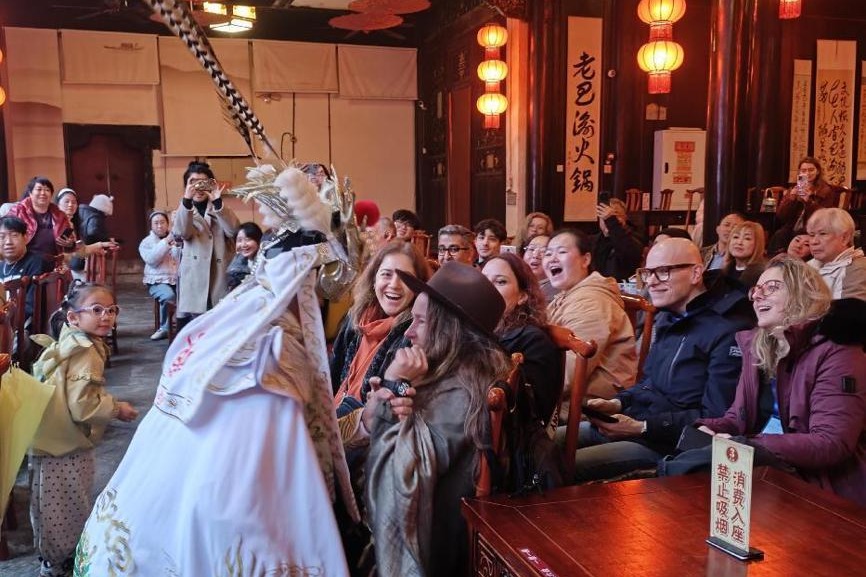Ancient Chinese gardens: Landscaping techniques


The landscaping of ancient Chinese gardens stresses the harmony and coordination between man and nature by using multiple design methods to best express the beauty of nature. The basic methods of landscaping for ancient gardens involve borrowing, adding, framing, revealing, contrasting, suppressing and blocking. The methods used depend on the nature and size of the garden, as well as the location and time.
Borrowing means introducing scenery from outside the garden to increase the depth of field and add more layers, thus creating unlimited views in a limited space and integrating elements within and without the garden. Borrowing includes far borrowing (remote mountains), near borrowing (big trees), upward borrowing (buildings and pavilions), downward borrowing (fish in the pond) and seasonal borrowing (flowers and plants). Borrowing can expand the space of the garden, create vivid images, and add layers to views, and that is why it has an extremely important role in the art of garden design in China. The famous garden designer Ji Cheng said in The Craft of Gardens that "the subtlety is in borrowing, and the refinement is in proper design". The Chengde Mountain Resort borrows natural mountains and the Eight Outer Temples to create an image of a "garden outside the garden" and "scenery outside the scenery".
Adding refers to the practice of adding scenery to an open field, a simple landscape or a place that lacks depth of field to change the situation. If there are mountains and towers far away and no transitions in the middle, then it feels empty and lacks a sense of layers. Adding some trees, plants and flowers as decorations can create a better picture. Kunming Lake is the front view, the Wanshou Mountain the back view, and a long corridor added between them creates a lovely and perfectly harmonious scene.
Framing means introducing external views into the limited space as a frame. The frames applied can be doors, windows, caves, galleries and even tree branches. Framing can gather together scattered views, add a finishing touch, and realize a transition in the view by changing the viewer's vantage point, which in effect is a collection of the beauty of nature and art. The moon gate in the Slender West Lake in Yangzhou is the epitome of framing. Through only one gate, visitors can see the Bridge of the Five Pavilions, which is the landmark of Yangzhou.
Revealing refers to the practice of revealing views behind a flower wall and a gallery wall through windows, screens, branches and gaps between plants to combine beautiful views within and without the garden, gallery and woods. This is a method of creating a partly visible view that is elegant and mysterious.
Contrasting refers to the practice that allows for appreciating views from two points interchangeably. Many gardens in China apply this method, because Chinese gardens consist mainly of natural landscapes. These gardens often put a pond or pool in the middle as a main design element, and standing above the water can offer a good space to view things from a different perspective. The views around the pond -- from rockeries and trees to bamboo and stones -- can all be seen no matter where you stand.
Suppressing means temporarily hiding the best views in the garden in order to reserve them for later. "Hiding before showing" and "suppressing before revealing" are the guiding ideas. This method can create an artistic effect that allows viewers to "suddenly see the light". Ancient gardens in China often use rockeries, trees and buildings to suppress the most important or beautiful views in the garden. By showing the greatest views later when visitors are in the mood, this method can enhance artistic appeal and offer the best experience. When visitors enter from the east gate of the Summer Palace, out of the Renshou Palace, and walk south along the path southeast of the courtyard house of Yulan Hall, they will see an earthen hill and trees, offering a good example of suppressing views. Combined with the method of borrowing, including upward borrowing (buildings and pavilions), downward borrowing (fish in the pond) and seasonal borrowing (flowers and plants), it can produce great results. Borrowing can expand the space of the garden, create vivid images, and add viewing layers, and that is why it has an extremely important role in the art of garden design in China. The famous garden designer Ji Cheng said in The Craft of Gardens that "the subtlety is in borrowing, and the refinement is in proper design". The Chengde Mountain Resort borrows natural mountains and the Eight Outer Temples to create an image of a "garden outside the garden" and "scenery outside the scenery".
Blocking means using rockeries, trees and buildings to block views that are not good for expressing the beauty of the garden, while at the same time add to the decor of the landscape in design. If there are unsuitable spaces ahead, or buildings or objects that will undermine the beauty of the garden, attractive features can be built in to block the view and enhance the beautiful landscape. Examples include screen walls placed ahead, and a wall of closely planted pine trees on both sides of the garden path.
- Avalanche in Xinjiang leaves one dead
- Research ward at children's hospital in Shanghai treats over 200 patients with rare diseases
- Chongqing symposium examines planning cities around sound, smell, touch
- Former Qingdao legislature chief under investigation
- Former Xinjiang prosecutor Guo Lianshan under investigation
- Shandong and SCO discuss trade, investment and supply chain cooperation





































